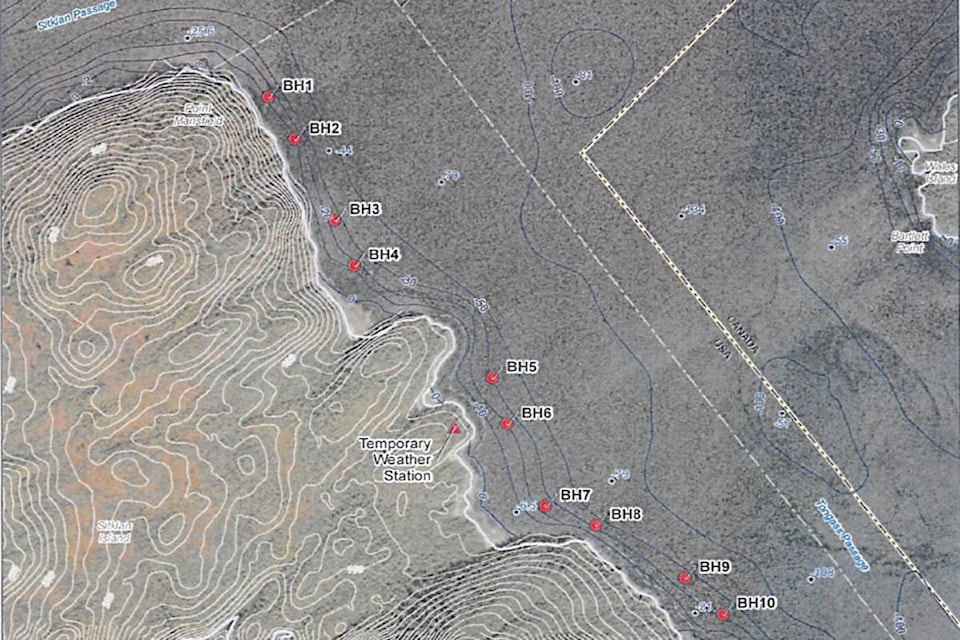A new company called AlaskCAN International LNG has proposed to build a $12 billion natural gas export terminal near the northern B.C. town of Prince Rupert, just over the Canadian border in Alaskan waters.
If everything goes according to AlaskCAN’s plan, the plant could be operational by 2027 or 2028.
The proposal outlines a floating terminal between Wales Island B.C. and Sitklan Island in Alaska, within the Tongass Passage to produce and export up to 12 million metric tonnes per year of liquefied natural gas (LNG)
There are those however, who say another LNG facility in the region is not required.
Larry Persily, professor at the University of Alaska Anchorage has pursued the global gas markets for decades. He said the market is adequately supplied, especially with the Kitimat, B.C. LNG plant currently under construction and located just 70 miles (112 kilometres) away from the AlaskCAN proposed site.
He added that a new facility that would attract massive gas tankers to the area may not be amenable to local community members.
“Fishermen are not big on large tankers going through their fishing grounds,” Persily said. “Fishermen may say, it’s just gas — not oil, but then they realize 15 tankers per month going through their fishing grounds is not benign.”
READ MORE: Chinese LNG distributor proposes LNG processing facility in Terrace
Byng Giraud, president of AlaskaCAN LNG, said his company is investigating sites for a floating liquefaction plant, just over the B.C. border in southeast Alaska.
The plan is to take up to 12 million metric tonnes per year of LNG and ship it to Asian markets. This will require a liquefaction platform attached to a small island, said Giraud in a recent interview with Alaska’s Energy Desk.
A liquefaction plant is needed to cool natural gas down to the point of condensation so it’s a liquid for shipping purposes.
Giraud said, his company hopes to capitalize on the natural gas trapped in northern B.C. “With the shale gas revolutions, directional drilling and all those technological advances of the past 15 years, we’re awash with gas, so that gas is looking for a market, ” he said.
It would be almost as easy to ship the gas from the Kitimat LNG Canada terminal, which is already under construction, said Persily. The $12 billion early estimates of the project cost do not include the 12-mile (19 kilometres) pipeline that would need to be constructed. Persily said the economics just don’t make sense. The added cost of the pipeline construction will bring the cost of the project up to around $20 billion. He said it would make more sense for the terminal in Kitimat to proceed to phase 2, than to build a whole new site.
READ MORE: How four changes to the Fisheries Act may affect the North Coast
“We like the Alaska side, partially because it makes the pipeline shorter - saves about 60 kilometres. And Alaska has a fairly robust permitting process,” Giraud said.
Persily said he’s not sure he agrees. “I’m not sure regulation is easier, but it’s that regulators have more experience. It’s not regulation issues that affect projects from proceeding. It’s environmental, economics and First Nations rights”, Persily said, “At some point fishermen are going to be concerned and not want tankers in their waters.”
Little information could be found on AlaskCAN International LNG. Giraud the president is based in Vancouver and until July, was a top executive in charge of business development for Woodfibre LNG. Another of his previous positions from 2010 was as vice president of corporate affairs for Imperial Metals, who own the Mount Polley Mine, responsible for what some called the environmental catastrophe, in the Williams Lake/Cariboo Region of B.C. in Aug. 2014.
K-J Millar | Journalist
Send K-J email
Like the The Northern View on Facebook
Follow us on Twitter
